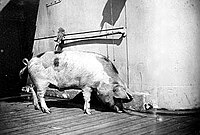HMS Glasgow (1909)

| |
| History | |
|---|---|
| Name | HMS Glasgow |
| Builder | Fairfield Shipbuilding and Engineering Company, Govan |
| Laid down | 25 March 1909 |
| Launched | 30 September 1909 |
| Commissioned | September 1910 |
| Fate | Sold for scrapping 29 April 1927 |
| General characteristics | |
| Displacement | 4,800 tons |
| Length | 453 ft (138 m) Overall |
| Beam | 47 ft (14 m) |
| Draught | 15.5 ft (4.7 m) |
| Propulsion | list error: <br /> list (help) Parsons turbines Four screws Twelve Yarrow boilers 22,000 hp |
| Speed | 25 knots (46 km/h) |
| Range | list error: <br /> list (help) carried 600 tons (1353 tons maximum) coal 260 tons fuel oil |
| Complement | 411 |
| Armament | list error: <br /> list (help) 2 × BL 6-inch (152.4 mm) Mk XI guns 10 × BL 4-inch (101.6 mm) Mk VII guns |
| Armour | list error: <br /> list (help) 2 inch, 1¾ inch, ¾ inch deck 6 inch conning tower |
HMS Glasgow, the sixth ship of that name, was launched on the Clyde at Govan in 1909 and was a Town-class light cruiser.
On the outbreak of the First World War, she was operating off the coast of South America under Captain John Luce, and on 16 August 1914 she captured the German merchant ship SS Catherina. In the South Atlantic on 1 November 1914, she saw action at the Battle of Coronel, when, together with the cruisers HMS Good Hope and HMS Monmouth, she engaged the German East Asia Cruiser Squadron, including the new cruisers Scharnhorst and Gneisenau. Having inflicted little damage on the enemy, Glasgow escaped with moderate damage considering that an estimated 600 shells were fired at her, although the other British cruisers were lost with all hands. Next month, in the battle of the Falkland Islands, in company with the battlecruisers Invincible and Inflexible, the battle with Admiral Von Spee was resumed on more advantageous terms. The victory was convincing with HMS Glasgow helping sink Leipzig. Another German ship, Dresden, escaped this particular battle, only to be later found by the Glasgow and HMS Kent and forced to scuttle after a short battle near Mas a Tierra. After the sinking a sailor from Glasgow noticed a pig swimming in the water and after nearly being drowned by the frightened pig, succeeded in rescuing him. The crew named him 'Tirpitz', and he served as the mascot of HMS Glasgow for a year and was then transferred to Whale Island Gunnery School, Portsmouth for the rest of his career.[1]

Glasgow was assigned to operate in the Mediterranean in 1915, and in 1917 was reassigned to the 8th Light Cruiser Squadron in the Adriatic Sea. In early 1917, "Glasgow" accompanied HMS Amethyst in patrolling the Brazilian coast for German raiders, such as SMS "Möwe"[2].
After the war Glasgow served briefly as a stokers' training ship before being paid off in 1922 and sold for scrapping on 29 April 1927 to Ward, of Morecambe.
Mt. Glasgow in the Canadian Rockies in Alberta, Canada is named after this ship.
References
- ^ Royal Philatelic Society London
- ^ Ship's logs for HMS "Amethyst" e.g. http://oldweather.s3.amazonaws.com/ADM53-33549/ADM53-33549-143_0.jpg
- Colledge, J. J.; Warlow, Ben (2006) [1969]. Ships of the Royal Navy: The Complete Record of all Fighting Ships of the Royal Navy (Rev. ed.). London: Chatham Publishing. ISBN 978-1-86176-281-8.
- Jane's Fighting Ships of World War One (1919), Jane's Publishing Company
- Gray, Randal (ed), "Conway's All The Worlds Fighting Ships, 1906-1921", (Conway Maritime Press, London, 1985), ISBN 0-85177-245-5
- Ships of the Bristol group
